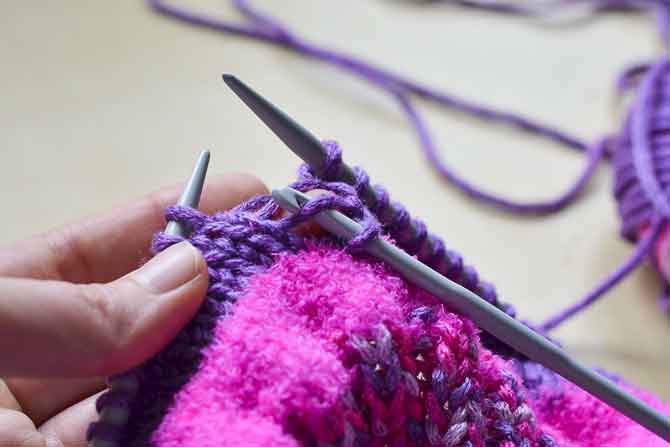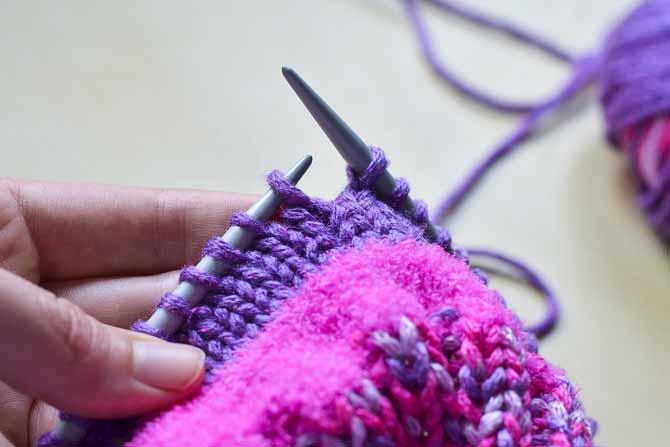When was the last time you discovered a dropped stitch in your knitting? If you’re a new knitter this might be a very stressful situation! But I can tell you that as knitter of more than 10 years, I still drop stitches from time to time. And, as long as you discover the dropped stitch within a few rows, you should be able to fix it pretty easily. In this post we’re rounding out some “Knitting 102” tips by showing you how to fix a dropped knit stitch!

The dropped stitch can happen when you least expect it! But it can be easily fixed.
The first thing to do, once you discover the dropped stitch, is to make sure it doesn’t drop down any farther. Grab a stitch marker (or safety pin) and close it through the live stitch.
Next, you’ll need a crochet hook, preferably one that is close to the size of the needles you used to knit your project. I used a 5.5mm needle for this Top This hat, and didn’t have that exact crochet hook size nearby so the 4.5mm hook was the closest size I had available. This is fine, since you’re not actually going to be using it for crochet, just to do a quick pick-up.

Step 1: Secure the live stitch with a stitch marker so it doesn’t drop any further.
To pick up the dropped stitch, you’ll need to pick it up several times, one on top of each other, since there are several loose strands there that need to be corrected. This is actually fairly simple. Follow these steps:
After securing the stitch and locating your crochet hook, remove the stitch marker and then insert the crochet hook through the stitch (pictured below).

Step 2: Insert a crochet hook through the front of the stitch.
Next, use the crochet hook to grab the first loose strand above the live stitch, and then pull that loop through the stitch that is still on your hook. Leave this newly pulled stitch on the crochet hook, and repeat those steps over and over again until you have caught all of the loose strands, one at a time. You’re done!

Step 3: Use the crochet hook to grab the loose bar just above the dropped stitch….

…and pull that bar through the dropped stitch. Leave the pulled loop on the crochet hook and repeat the process.
The line of stitches you’ve just picked up will probably be a little bit looser than the original knitted fabric was, but once you’ve finished the project and given it a wash, you’ll never know the difference.

Place the last pulled-up stitch back on the needle, and you’re done! You’ll never know the difference.
If you’ve managed to drop two or three stitches, all right next to each other, then you can still use this same process but will need to work one stitch at a time. It’ll be a little more painstaking, but can be done.
The alternative, of course, is to simply pull out your knitting as far as the stitch has dropped, and re-knit from that point. The choice is yours about which would be more time consuming or frustrating! Usually the crochet hook solution is the faster choice. Next time you find yourself in this situation, you’ll know how to fix a dropped knit stitch!

1 comment
This is a great tip! Wish I had known about this when I first started knitting and, if I dropped a stitch, I always ripped back to the beginning and started over! Not the best use of my time.